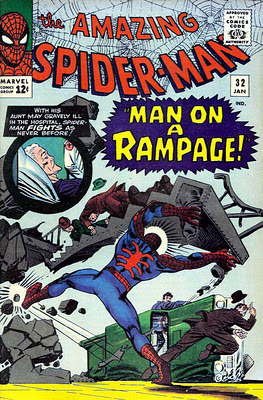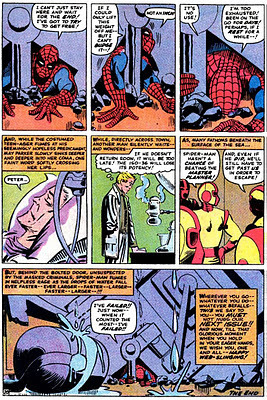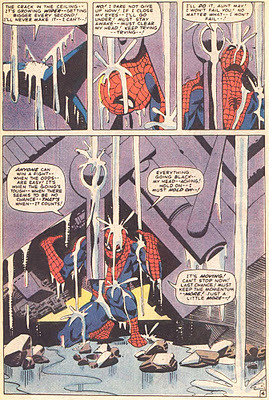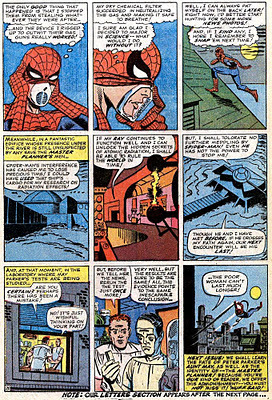How to Do Continued Stories and Next or Future Issue Teases – Part 2
The Best Cliffhanger Ever
I remember buying this comic book at Churchill's Pharmacy, corner of South Park Road and Brightwood Road, Bethel Park, Pennsylvania. It was October, 1965. I had just turned fourteen.
 I read the book in the store, after paying for it. They were nice at Churchill's but like everywhere else, if you read the books before buying them, they'd remind you "this isn't a library."
I read the book in the store, after paying for it. They were nice at Churchill's but like everywhere else, if you read the books before buying them, they'd remind you "this isn't a library."The issue contained the second chapter of a three-part story, fondly referred to around Marvel in my day as the "Master Planner Sequence." This chapter, "Man on a Rampage," features Spider-Man on a desperate quest to recover the only thing that can save his beloved Aunt May's life, a serum called ISO-36, the only supply of which has been stolen by the Master Planner's thugs.
The Master Planner turns out to be Doctor Octopus. Spider-Man ends up battling Doc Ock in his underwater hideout. Spider-Man's desperate fury drives away Doc Ock, but their battle has so damaged the structure that, as Doc Ock flees, an immense piece of equipment topples over on Spider-Man pinning him under it.
He's trapped.
The container with the serum lies tormentingly in sight.
The dome overhead is breaking up. Water is rushing in.
There is no way out. No hope.
For me, that was the best cliffhanger ever:
 That's just me. I'm sure you have your own favorites. But I won't ever forget standing agape in Churchill's Pharmacy trying to process the realization that I'd have to wait an entire month to see what happened.
That's just me. I'm sure you have your own favorites. But I won't ever forget standing agape in Churchill's Pharmacy trying to process the realization that I'd have to wait an entire month to see what happened.As for the story, well, some would say it was amazingly coincidental that Doctor Octopus happened to need, and steal, the only thing that could save Aunt May. Stan did justify it to some extent, though. Aunt May was dying because of radioactivity in her blood. Her blood was contaminated by a transfusion of nephew Peter/Spider-Man's radiation-altered blood. Like Spider-Man, Doctor Octopus gained his powers from radiation. It is not an inconceivable stretch that he'd be interested in a serum that affects radioactivity in the blood.
Yeah, I know, it's still a coincidence.
But as I often say, you have to look at those early sixties stories in the context of the times. Back when Superman's main problem seemed to be keeping Lois from guessing his secret identity, the emotional content of the Master Planner Sequence was stunning.
So Stan did that leg of a three-part continued story in the "normal" way, generating powerful conflicts, building to a climax/cliffhanger and breaking there. "As seen on TV," you might say, since that's the technique employed almost exclusively by usually-one-part TV dramas that have a special two-parter. It was/is the standard even for sitcoms.
And the pay-off was great:
 [image error]
[image error]
Baiting the Hook
As noted yesterday, there are many ways to do multi-issue or continued stories. Not all involve a climax/cliffhanger.
If you don't have that how am I going to wait a whole month to find out what happened cliffhanger? to bring the readers rushing back, how do you do it?
Lots of ways.First, and ultimately the most important, nothing makes a reader more inclined to pick up the next issue than if the book they just read is great. That's the mightiest hook you can sink.
If the book in hand is terrific, other kinds of teases may not be needed, but won't hurt. If the book in hand is, perhaps, good, but not the greatest issue of all time, teases may help.
If the book in hand is bad, well, probably nothing you can do will work. But, if the teases are really compelling, at least there's hope that the reader will give you one more chance.
The simplest tease is the next issue blurb. Even if it's just the title, if it's a really compelling title, that can stir interest.
I've know I've written a few good titles along the way. I can't think of any right now. Maybe they weren't that good.
Aha! I came up with one for Legion of Super-Heroes #42, in which the Legionnaires are in terrifying danger but have gotten new, protective costumes: "Fear and Clothing."
Well, I liked it. And the editor laughed out loud.
Ahem.
Anyway….
Some little hint about the must-see events that will occur in the next issue is good, too. At the end of Amazing Spider-Man #31, Stan wrote:
"Next issue: We shall learn the fate of Peter Parker's Aunt May, as well as the identity of – the Master Planner!"
Okay.
The next level of tease is, essentially, a dramatization of the next issue blurb/hint about must-see things in store—a page, a few panels or a single panel that plays out a dramatic development that affects next issue. In addition to his next issue blurb, Stan used that type of tease at the end of the first chapter of the Master Planner Sequence:
 Stan was amazing. He had range. He was able to get me just as worried about Aunt May's illness as he did about the coming of Galactus.
Stan was amazing. He had range. He was able to get me just as worried about Aunt May's illness as he did about the coming of Galactus. It's a good thing. He didn't offer a title for issue #32 and the next issue blurb admonishment "You must not miss it! 'Nuff said!" is right up there with the lamest of all time.
If he had given the title of the next chapter, "Man on a Rampage!" I think that would have sold me all by itself.
But, as you see, other than for the usual problems he's aware of, Spider-Man is hale and hearty. There is no intense, immediate, hero-in-peril cliffhanger.
Next issue blurb dramatizations are not limited to panels or sequences at the end, of course. Well-crafted panels or sequences not directly involved with or critical to the main story in the issue somewhere in the middle can be just as effective. The key term is "well-crafted." If it's good, clear and comprehensible as a portent of things about to happen that relate to the main story, it's a tease. If it's one of those what's-this-and-what's-it-got-to-do-with-anything? confusing bits, it's bad writing.
NEXT: Long Term Teases, or This Better Be Good….
Published on November 02, 2011 13:28
No comments have been added yet.
Jim Shooter's Blog
- Jim Shooter's profile
- 85 followers
Jim Shooter isn't a Goodreads Author
(yet),
but they
do have a blog,
so here are some recent posts imported from
their feed.



